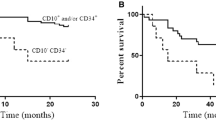Abstract
The multidrug resistance 1 (MDR1) gene product, P-glycoprotein (Pgp/p170) is a membrane protein, which acts as an ATP dependant efflux pump that expels a wide variety of organic compounds including chemotherapeutic agents from the cell. Pgp over expression has been demonstrated to be linked with poor treatment outcome and poor prognosis in a number of malignant tumors. AgNORs is a simple, reliable and inexpensive method of evaluating the proliferative activity of a tumor. We have studied MDR1 expression and AgNORS in 41 cases of acute leukemia in children. In this study, AgNOR counts in patients with acute lymphoblastic leukemia (ALL) L2 subtype (FAB classification) were significantly higher as compared to the ALL L1 subtype. Similarly, mean AgNOR count in the acute myeloid Leukemia (AML) M2 subtype was significantly higher as compared to the ALL L1 subtype. However, there was no correlation between AgNOR and treatment outcome or between AgNOR counts and MDR1 expression in any of the subtypes of acute leukemia included in this series. In AML, MDR1 gene expression was found to be related to reduced remission induction rates and hence poorer prognosis. In ALL, our study has shown no difference in remission induction between MDR1 positive and MDR1 negative cases. This would suggest that factors other than MDR1 may be of relevance in Pediatric ALL.
Similar content being viewed by others
Abbreviations
- ALL:
-
Acute lymphoblastic leukemia
- AML:
-
Acute myeloid leukemia
- MDR1:
-
Multidrug resistance 1
- Pgp:
-
P-glycoprotein
- AgNOR:
-
Nucleolar organizer regions
References
Haber DA (1992) MDR in leukemia: is it time to test? Blood 79:295–298
Flens M J, Guido JRZ, Van der Valk P et al (1996) Tissue distribution of the Multidrug Resistance Protein. Am J Pathol 148:1237–1247
Macfarlene A, Dawson A, Pearson CK (1995) Analysis of MDR1 and MDR3 multidrug resistance gene expression and amplification in consecutive samples in patients with acute leukemias. Leuk Lymphoma. 19:135–140
Baccarani M, Damiani D, Michelutti A, Icheli M (1993) Expression of MDR1 in normal hematopoietic cells. Blood 81:3480–3482
Eric S, Bernard D, Lydia C et al (2003) Quinine as a multidrug resistance inhibitor: a phase 3 multicentric randomized study in adult de novo acute myelogenous leukemia. Blood 102:1202–1210
Ross DD (2004) Modulation of drug resistance transporters as a strategy for treating myelodysplastic syndrome. Best Pract Res Clin Haematol 17(4):641–651
Pich A, Chiusa L, Audisio E, Marmont F (1998) Nucleolar organizer region counts predict complete remission, remission duration, and survival in adult acute myelogenous leukemia patients. J Clin Oncol 16: 1512–1518
Crocker J, Boldy DAR, Egan MJ (1989) How should we count AgNORS? Proposal for a standard approach. J Pathol 158:185–188
Catovsky D (1995) Leucocyte cytochemical and immunological techniques IN Dacie S, Lewis R Eds Practical Hematology, seventh edition, London, Churchill Livingstone. pp 125–155
Bennet JM, Catovsky D, Daniel MT et al (1976) Proposals for the classification of acute leukemias. Br J Haematol 33: 451–458
Bennet JM, Catovsky D, Daniel MT et al (1981) The morphological classification of acute lymphoblastic leukemia Concordance amongst observers and clinical correlations. Br J Haematol 47:553–561
Filipits M, Suchomel RW, Lochver K et al (1997) Immunohistochemical detection of the multidrug resistance associated protein and Pgp in acute Myeloid Leukemia. Leukemia 11:1673–1677
Musto P, Melillo L, Lombardi G et al (1991) High risk of early resistant relapse for leukemia patients with presence of MDR associated Pgp positive cells in complete remission. Br J haematol 77:50–53
Goasguen JE, Dossot J-M, Fardel JO et al (1993) Expression of P-170 in 59 cases of de novo ALL: Prognostic implications. Blood 81:2394–2398
Gale RP (1986) Leukemia treatment. Boston: Blackwell; pp 124–136
Casale F, D’Angelo V, Addeo R et al (2004) P-glycoprotein 170 expression and function as an adverse independent prognostic factor in childhood acute lymphoblastic leukemia. Oncol Rep 12:1201–1206
Campos L, Guyotal D, Archimband S et al (1992) Clinical significance of multidrug resistant P-glycoprotein expression in ANLL at diagnosis. Blood 79:473–476
Dhooge C, De Moerloose B, Laureys G et al (2002) Expression of the multidrug transporter P-glycoprotein is highly correlated with clinical outcome in childhood acute lymphoblastic leukemia: results of a long-term prospective study. Leuk Lymphoma 43:309–314
Asakura K, Uchida H, Miyachi H et al (2004) TEL/AML1 overcomes drug resistance through transcriptional repression of multidrug resistance-1 gene expression. Mol Cancer Res 2:339–347
Shome DK, Khurana N (1999) Distinctive AgNOR patterns of myeloid and lymphoid blasts in acute leukemia. Am J Hematol 61:149–152
Sreelekha TT, Kusumakumary P, Srinivas G et al (1996) Argyrophilic nuclear organizer regions (AgNORs) in pediatric acute lymphoblastic leukemia. Cancer Lett 108(12):87–91
Author information
Authors and Affiliations
Corresponding author
Rights and permissions
About this article
Cite this article
Balamurugan, S., Sugapriya, D., Shanthi, P. et al. Multidrug resistance 1 gene expression and AgNOR in childhood acute leukemias. Indian J Hematol Blood Transfus 23, 73–78 (2007). https://doi.org/10.1007/s12288-008-0002-2
Published:
Issue Date:
DOI: https://doi.org/10.1007/s12288-008-0002-2




